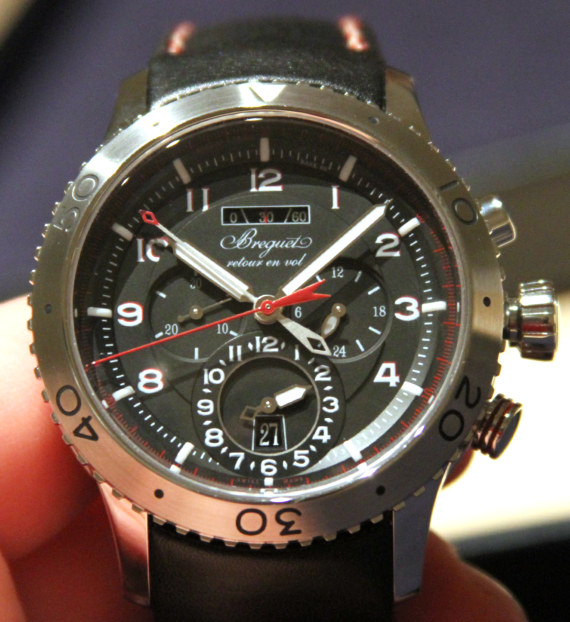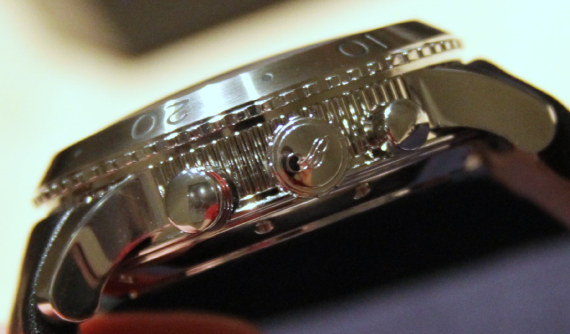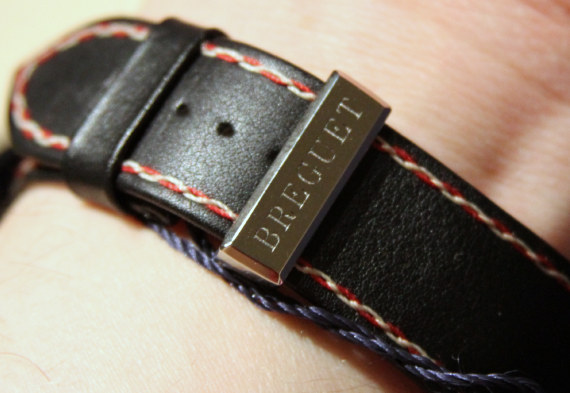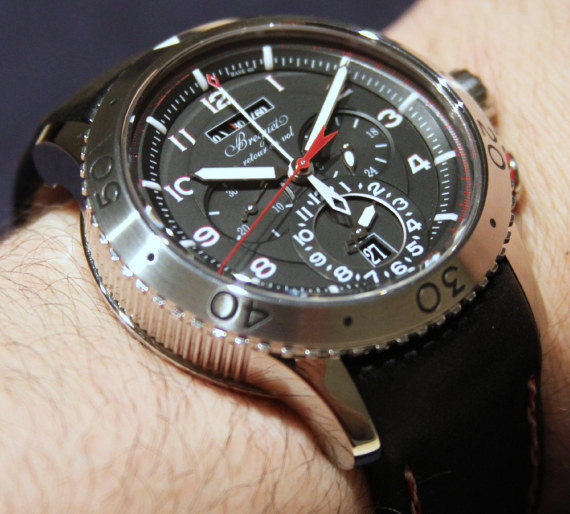
On the list of watches that I would brutally and without remorse murder for is the Breguet Transatlantique Type XX and possibly the Type XXI (in the right color scheme). Representing a less brutally expensive Breguet, the Type XX and XXI are wonderful sport watches with a beauty that is deserving of the Breguet name. For 2010 Breguet has released the Type XXII watch into the mix. Known more directly as the Type XXII Flyback Chronograph GMT 3880 ST, the watch is also meant as a 50th anniversary piece for the first of these model which were originally made for the French naval air force (see the limited edition collection that stemmed from that anniversary here). A beautiful watch by most angles, is gets so complex and hard to understand, the passion for me is lost. It isn’t that I am a moron and need only “simple” watches, it is rather that I don’t like to look at a dial and immediately get confused. Even while having Breguet show me the watch, we were unclear as to how to operate it. Which then inspires that dependable catch-all phrase “this is just a semi-functional sample piece.” Sure… In a nutshell, I think that what they are trying to do with the watch is great, but it comes across as being confusing. Not just in operation, but as in “why even do that?” Sort of like the answer to a question no one asked.
The Type XXII watch has some very cool things about it, both visually and technically. Of interest is the very high beat movement that operates at 72,000 vph (vibrations per hour). This is very, very fast. Most nice movements operated at about 28,000, and the Zenith El Primero goes at about 36,000. So up to 72,000 (10 hertz) is a major step up. This means that the chronograph for example can be used to measure very small fractions of a second. It is so fast, that the chronograph seconds hand rotates the entire dial in just 30 seconds. Breguet says this allows the watch to measure time with “twice the precision.” Which is another discussion unto itself, but you can measure up to 1/20 of a second precision with this baby. Though really, if you want that much precision when timing with a watch, get yourself a quartz Casio.

OK, so before I talk about the prettiness of the piece, let’s talk functionality. Inside the watch is an automatic Breguet 589F movement with a silicon escapement, silicon balance-spring, and 45 hours of power reserve. These latter two silicon parts are a major part of the high beat ability of the movement. Functions include the time, date, a 60 minute chronograph, and a GMT hand that comes with a synchronized 24 hour hand. Let’s talk about the GMT hand first. The lower subdial at 6 o’clock has a large 12 hour hand which is the GMT hand for a second timezone. It has a synchronized 24 hour hand at 3 o’clock so that you can know whether it is AM or PM in that second timezone. If the AM/PM indication was so important, wouldn’t it just make sense to have the second timezone hand in 24 hour format? So much of the dial is taken up but this redundancy. Sure, “no one else has done this before.” Maybe for good reason. I don’t know why the lauded Breguet had to “innovate” in this department. I can see the Seiko engineers laughing about stuff like this.

Then you have the chronograph, a poor overly complex 60 minute chronograph. So the main dial has two hands. The red chronograph seconds hand, and the white hand with the red arrow tip. The flyback chronograph seconds hand moves around the dial once each 30 seconds. In order to know whether it is on its first or second pass for that minute, you can look at the linear-style dial sitting under 12 o’clock (which goes from 0-60). Leave it to Breguet to make using a chronograph too quirky to be fun. I am sure the device is fun to watch, but hard to feasibly use for any serious purposes. You read the elapsed minutes via the white centrally mounted hand with the red tip – which uses the main dial for this function. The subdial at 9 o’clock is for the seconds for the main time.
So basically what Breguet did is force people who buy this watch to rethink what certain dials are used for. Nothing on the watch feels intuitive. You see certain scales, and placements of dials on the watch and want it to do one thing, when in reality is does another. I see two thin hands on the main dial, and I think rattrapante. I see a linear scale style dial and I think power reserve indicator. I see a synchronized 24 hour hands and I think it is for the main time, not the second time zone. There is just so much to remember with the Type 22 (XXII) watch. I do further fear that the movement is too complex. I could be totally wrong, but I think that it will take Breguet a while to work the kinks out of this complex little mechanical dancing number.

Visually the dial looks great. Cool looking, and easy to read (for the time that is). The multi-level dial is easy on the eyes, and the hands and numerals are easy to read. The 44mm steel case is beautiful and complex (water resistant to 100 meters), building on the classic complexity of the Type XX and XXI designs. Case has a rotating diver’s style bezel and a very handsome look. Check out the two-tone crossed stitching on the leather strap. Is that fancy looking or what?
I just want the dial and functions of the watch to be more straight forward. I am all about complexity and complications, but make it matter! Here, I just feel like they wanted to do something different. The complex, high beat movement inside could be emphasized better, and the functionality needs to be seriously streamlined. This watch just didn’t feel thought-out enough. The sporty line from Breguet deserves better, something more inspired to be worn and used, rather than to have mere bragging rights on paper. I’d gladly wear the Breguet Type XXII Flyback Chronograph GMT watch because it looks good. But I would abstain from using its functions out of protest! Price is in the $18,200 range.
See Breguet watches on eBay here.